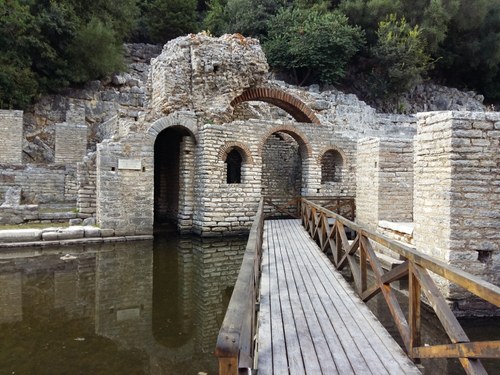Shrine of Asclepius

Discovered during the excavations of the theater in 1929 by L. M. Ugolini, the shrine of Asclepius is a small temple-like building partially hidden by the structures of the cavea of the theatre and divided inside into pronaos and naos. Much of what we see today is the result of the Roman reconstruction, however it seems that it was first built during Hellenistic times: its terminus ante quem is considered the dedicatory inscription in the Theatre, which can be dated between 232 and 167 BC. Nowadays it is believed to have been built between the end of the 4th and the beginning of the 3rd century BC. It has the same building technique as the theatre, with a central door and two symmetrical windows on the sides. The central door opens onto the pronaos, paved with irregular stones, through which there is the access to the naos, provided with a bench all around the west wall and a small window near the NE corner. The upper side of the bench had a series of rectangular and square inserts in which votive objects were probably inserted. The bench itself is made from reused materials, especially fragments of stelae and inscribed blocks. Ugolini decided to dismantle it to recover the individual objects. Ugolini believed that there had been an altar of an earlier age based on the irregularity of the floor and the findings in the deposit. Ugolini believed there had been a prostyle temple in antis and that in the Roman phase the temple had been completely rebuilt, enlarged on the west and north part and equipped with a brick roof covered by rubble concrete as support for the extension of the theatre.
Behind the rear wall of the Shrine a chamber (favissa) with a votive deposit was found, over 300 objects mostly from the Hellenistic period with the name of Asclepius on them. Here there was also the so-called altar of the priest Philistus. These objects were displayed or conserved in this shrine and then collected in the favissa in order to make space for new votive objects. This pottery has been fundamental for dating the whole complex of the Sanctuary of Asclepius, however it is not available anymore for study. Recently, starting from Ugolini and P. Cabanes's work, N. Aleotti, A. Gamberini and L. Mancini have re-studied the chronology of these materials, focusing in particular on the vessels and the ritual objects. They found out not only that these objects displays adherence to the model of the Asklepieion in Epidaurus, but also that their dating can be confined to the 2nd century BC and not anymore to the first phases of the Sanctuary, even though this does not mean that the worship began at the same time in the city.
This building was surely not a real temple: the parodos already existed and the subsequent Roman stage would have made it difficult to make the sacrifices. Furthermore, the small size and lack of monumentality of the structure make it difficult to believe that this was the only temple of the god. The objects found suggest that at least in its final phase the structure was used to preserve many statues and objects that were therefore no longer usable in worship. From the analysis of the so-called altar of Philistus and the opening of the naos, it was interpreted as a thesauros where the wealth of the sanctuary and the most important objects for worship were kept. Thesauroi are often associated with Asklepieia.
The theatre is directly connected to it, but the first phase of the thesauros precedes its construction. During the Roman phase, the thesauros became subordinate. It can be supposed that the wealth of the sanctuary came from the tampering of slaves carried out by the priests and that when public income ceased to exist in Roman times, the sanctuary lost its importance, being incorporated into the theatre and becoming only a sort of deposit for the objects of the god.
Bibliography on the subject
- Aleotti N., Gamberini A., Mancini L., "Sacred places, territorial economy and cultural identity in northern Epirus (Chaonia)", in Giorgi E., Lepore G., Gamberini A., Boundaries Archaeology: Economy, Sacred Places, Cultural Influences in the Ionian and Adriatic Areas, Panel 7.3, Archaeology and Economy in the Ancient World 39, Heidelberg, Propylaeum, 2020, pp. 45-63
- Gilkes O., The theatre ad Butrint. Luigi Maria Ugolini's excavations at Butrint 1928-1932, London, The British School at Athens, 2003
- Hansen I. L., Butrinti helenistik dhe romak. Hellenistic and Roman Butrint, London - Tirana, 2009
- Mancini L., "Templi, thesauroi, “temples-trésors”. Note Sull’edilizia Templare Non Periptera Nei Santuari Dell’epiro Ellenistico" in Ocnus, vol. 21, 2013, pp. 75-100
- Mancini L., "Edilizia templare nell'Epiro indigeno. Archeologia e architettura di un paesaggio sacro periferico", PhD thesis, University of Bologna, 2015
-
Melfi M., "The Sanctuary of Asclepius" in Hansen, Roman Butrint. An assessment, Oxford, 2007, pp. 17-32
-
Melfi M., "Butrinto: da Santuario di Asclepio a centro federale", in de Marinis et al., I processi formativi ed evolutivi della città in area adriatica, Oxford, 2012, pp. 23-30
-
Ugolini L. M., Butrinto. Il mito di Enea e gli scavi, 1937, pp. 152-159
- Ugolini L. M., L‘acropoli di Butrinto, Roma, 1942, pp. 91-146